We like to control things, so our first networks centralized control, until decentralized networks like Ethernet were found to be ten times faster. They also degrade gradually under load, instead of crashing suddenly, as centralized networks do. When the Internet was first proposed, it was expected to fall into chaos without central control, but it was decentralized control that enabled it to survive.
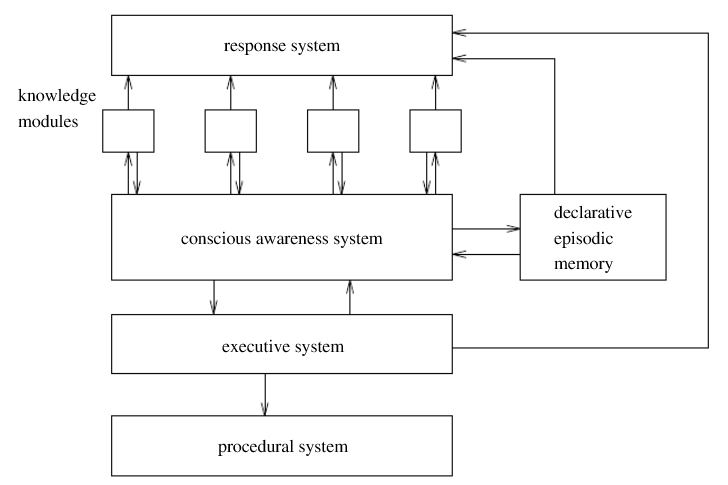
Early brain theories also expected a central executive. In Schacter’s model (Figure 6.5), an executive decides what to do after a conscious awareness unit accesses sensory knowledge modules, memory and higher reasoning (Schacter, 1989). The executive was assumed to be in the cortex, a folded layer wrapped around the midbrain and hindbrain (Figure 6.6) that handles voluntary acts, thought, planning, and language.
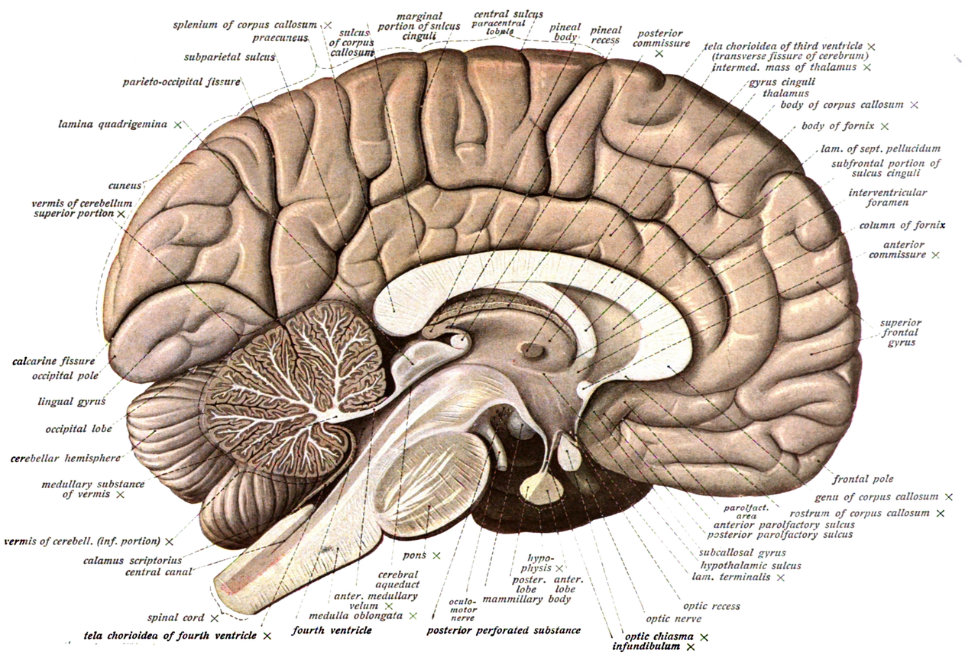
The cortex is the most advanced part of the brain, but its two hemispheres share the work between them. The left one directs the right side of the body and the right one directs the left. One specializes in language and the other in spatial analysis, but how can two hemispheres act as one executive?
The answer, revealed by a treatment of epilepsy, is that they don’t. In epilepsy, an electrical disturbance in one hemisphere spreads to incapacitate the cortex across an 800 million nerve bridge called the corpus callosum. Cutting it in animals didn’t seem to harm them, so surgeons tried the same in epileptics, to stop the epilepsy spreading. The treatment worked but while serious side effects were expected, split-brain patients spoke and acted normally! So little changed that some thought the corpus callosum was just a structural support. Further studies revealed an unexpected result.
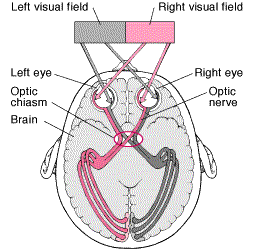
Each hemisphere moves the opposite hand but for vision, the left hemisphere inputs the right side of both eyes and the right one gets input from the left side of both eyes (Figure 6.7). In split-brain studies, each eye saw half a split screen, so with the corpus callosum cut, the left hemisphere saw only the claw and the right hemisphere saw only the snow (Figure 6.8).
When subjects were asked to point to a picture that matched what they saw, the right hand picked a chicken but the left hand picked a shovel! The left hemisphere saw a claw, so it used the right hand to point to a chicken, while the right hemisphere saw snow, so it used the left hand to point to a shovel, and neither was aware of the other’s choice. Both hemispheres could receive and send data as if each was a brain in itself, so there was no central executive.
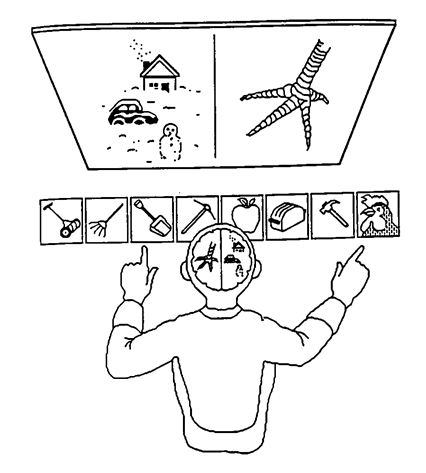
When asked why his left hand chose a shovel, a subject said “you need a shovel to clean up after chickens”. The verbal left hemisphere had no idea why the shovel was chosen, as it didn’t see the snow, but instead of saying I don’t know, it made up a story. It tried to interpret events as best it could:
“These findings all suggest that the interpretive mechanism of the left hemisphere is always hard at work, seeking the meaning of events. It is constantly looking for order and reason, even when there is none – which leads it continually to make mistakes. It tends to overgeneralize, frequently constructing a potential past as opposed to a true one.” (Gazzaniga, 2002) p30
Interpreter theory is that the cortex, with its language and thought, is more servant than master in the brain. If the brain is a federation of agents (Minsky, 1986), the left cortex is head of human relations not the CEO, as some suggest (Kaku, 2014). It is like a diplomat, whose job is to explain the decisions that others in power make.
Perhaps human intellect expanded when we formed tribes because those who better explain themselves survive to reproduce, as the animal most likely to harm a human is another human. Inventing acceptable reasons after the fact may be the evolutionary basis of our vaunted intellect. Logical thought, building one idea upon another in a rational way to reach an unforeseen conclusion, probably isn’t what our intellect originally evolved to do.
The left hemisphere usually specializes in language but the right hemisphere isn’t illiterate. One study of a split-brain boy (Wolman, 2012) asked the left hemisphere “Who is your favorite?” but flashed “Who is your favorite girlfriend?” to the right hemisphere. The left hemisphere made no verbal reply, as didn’t see the word girlfriend, but a nervous giggle revealed that the right hemisphere understood. The right hemisphere then used the left hand to select scrabble tiles to spell out L-I-Z, a cute girl in his class. The right hemisphere had no vocal control but it could still read and spell. Both hemispheres are conscious in any way you care to define it:
“Everything we have seen indicates that that the surgery has left these people with two separate minds, that is, two separate spheres of consciousness. What is experienced in the right hemisphere seems to lie entirely outside the realm of awareness of the left hemisphere. This mental division has been demonstrated in regard to perception, volition, learning and memory.” (Sperry, 1966)p299.
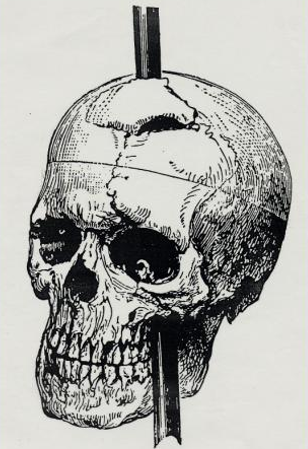
Evolution favors decentralization because then if part of the brain is lost, the rest can carry on. In a famous case, an iron rod pierced the middle and left cortical lobes (Figure 6.9) of a railway worker called Phineas Gage, who shortly after walked off, conscious and speaking. He showed disturbed behavior but lived for 13 more years and died of unknown causes. Now imagine banging a nail through a mother-board! The brain duplicates the cortex for the same reason that planes duplicate critical control units – to increase reliability. This answers Von Neumann’s question:
“How could a mechanism composed of some ten billion unreliable components function reliably while computers with ten thousand components regularly fail?”
As information goes into the brain, it makes sense to peel away the layers of processing to find the “I” from which all proceeds, but doing so reveals no central executive. If the body is a ship run by the brain, it has no “Captain”, even at the highest level:
“Studies of the structural and functional organization of the brain have shown that this organ is, to a large extent, decentralized, and processes information in parallel in countless sensory and motor subsystems. In short, there is no single homunculus in our brains that controls and manages all these distributed processes.” (Singer, 2007)
No-one searches the Internet to find its “center”, so why expect a brain network to have a center? Neither neuroscience nor information science support the idea that we have one “I”:
“In contrast to this first-person experience of a unified self, modern neuroscience reveals that each brain has hundreds of parts, each of which has evolved to do specific jobs – some recognize faces, others tell muscles to execute actions, some formulate goals and plans, and yet others store memories for later integration with sensory input and subsequent action.” (Nunez, 2016) p55.
Some argue that this conflict between the fact that we experience one observer and the fact that the brain has no central control area means one fact is wrong (Dennett, 1991), but science doesn’t work by cherry-picking facts. It works by accepting facts, putting questions and finding answers, so part 6.3 will later ask how can a decentralized brain can create one observer?